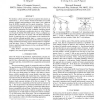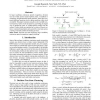20 search results - page 3 / 4 » Articulatory feature based continuous speech recognition usi... |
MLMI
2007
Springer
13 years 12 months ago
2007
Springer
Abstract. Prosody has been actively studied as an important knowledge source for speech recognition and understanding. In this paper, we are concerned with the question of exploiti...
TASLP
2008
13 years 5 months ago
2008
Abstract--This paper is concerned with the automatic recognition of dialogue acts (DAs) in multiparty conversational speech. We present a joint generative model for DA recognition ...
ICASSP
2009
IEEE
14 years 15 days ago
2009
IEEE
We introduce a direct model for speech recognition that assumes an unstructured, i.e., flat text output. The flat model allows us to model arbitrary attributes and dependences o...
INTERSPEECH
2010
13 years 17 days ago
2010
In large vocabulary continuous speech recognition, decision trees are widely used to cluster triphone states. In addition to commonly used phonetically based questions, others hav...
ICASSP
2009
IEEE
14 years 15 days ago
2009
IEEE
Model compensation is a standard way of improving the robustness of speech recognition systems to noise. A number of popular schemes are based on vector Taylor series (vts) compen...


